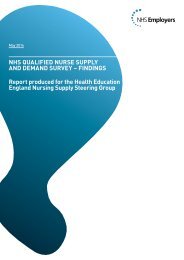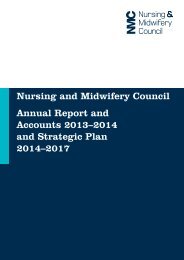Journal_1_2014_final_WEB
Journal_1_2014_final_WEB
Journal_1_2014_final_WEB
You also want an ePaper? Increase the reach of your titles
YUMPU automatically turns print PDFs into web optimized ePapers that Google loves.
Innovation, know how and technolgy in wound care<br />
Only a small proportion of patients with chronic ulcers<br />
are currently being treated by NPWT. This number is<br />
expected to grow in the next few years as the cost of<br />
NPWT decreases. The SWAN-iCare device will offer an<br />
optimised NPWT treatment for chronic ulcers characterised<br />
as “hard-to-heal”, allowing distant monitoring of<br />
the wound healing process in specific situations where<br />
the healing is expected to be more uncertain and more<br />
challenging.<br />
Expected benefits<br />
The development of products with sensors and ICT that<br />
allow remote monitoring of wound conditions may lead to<br />
benefits for patients and medical support teams at numerous<br />
different points along the patient’s treatment pathway.<br />
The expected benefits can be summarised as follows:<br />
Improved clinical outcomes:<br />
n Earlier identification of wound infections and<br />
wound deterioration, encouraging hope of a lower<br />
amputation rate<br />
n Better control and monitoring of exudate and compression<br />
n Access to detailed real-time quantitative data will<br />
contribute to evaluation of treatment effectiveness<br />
and wound healing progress and allow for individualised<br />
and fine-tuned treatment regimes<br />
More efficient use of resources<br />
n Reduced healthcare costs as a consequence of fewer<br />
complications and faster healing<br />
n Reduced healthcare costs as a consequence of a reduced<br />
need for hospitalisation and fewer visits to<br />
specialist wound centres through remote monitoring<br />
n Reduced time spent on dressing changes during<br />
nursing visits, allowing more time to be focused on<br />
other medical needs<br />
n Less potential waste of dressing materials as a result<br />
of a reduction in “unnecessary” dressing changes<br />
n Reduced cost to the social system and minimised loss<br />
of productivity associated with the patient returning<br />
to work earlier due to an improved wound management<br />
process<br />
Increased patient satisfaction and quality of life<br />
n Reduced disturbance to the patient’s life and possible<br />
reduced need for hospitalisation due to early identification<br />
of wound deterioration and faster healing<br />
n Personalised treatment adjusted on a daily basis to<br />
meet each patient’s individual needs<br />
n Patients can stay out of hospital while receiving<br />
treatment and thus feel more comfortable while at<br />
the same time being reassured that their condition<br />
is being safely and remotely monitored by specialist<br />
carers<br />
n Less dependency on clinical visits will reduce time<br />
and resources spent on transportation to specialist<br />
care units<br />
Better monitoring and documentation<br />
n Detailed and continuous data collection on central<br />
parameters important for wound healing will<br />
increase the level of knowledge and competence<br />
among the different service providers involved in<br />
wound care<br />
n A research dimension will be integrated into the<br />
project to develop a deeper understanding of wound<br />
healing through correlation and analysis of multiple<br />
wound parameter measurements<br />
How far are we from realising<br />
these goals<br />
By the end of the project period a clinically proven prototype<br />
SNPD will have been developed. However, as with<br />
other eHealth services, the technological development is<br />
itself only one part of the challenge of getting these types<br />
of systems integrated into routine care provision.<br />
Large-scale deployment and real-market uptake requires<br />
additional work to understand how implementation<br />
of these ICT systems will affect current workflows<br />
and any potential changes to the roles and responsibilities<br />
of staff involved in service provision throughout the treatment<br />
pathway. If this is not understood and accounted<br />
for, implementation could be hindered simply because<br />
organisations and staff are not ready to transform the way<br />
routine care is being provided.<br />
Another aspect is the business model. Clarification of<br />
where the reimbursement of such a system is to come<br />
from in different health care settings is a challenge that<br />
has hampered the uptake of similar products. For patients<br />
that end up receiving treatment and care from multiple<br />
sectors, the impact on budget for all the different levels of<br />
service providers will not be easy to establish. It may not<br />
always be obvious that the ones bearing the costs are the<br />
ones benefitting from the savings generated.<br />
To meet these challenges, part of the project deliverables<br />
will be to establish detailed stakeholder analysis as well<br />
as impact and cost effectiveness analyses that will lead to<br />
different roadmaps for adoption strategies based on the<br />
customers’ needs and expectations. <br />
m<br />
PROJECT FACTS<br />
Funding program: Seventh framework program:<br />
Large scale Integrating project proposal –<br />
ICT call 8 (FP7-ICT-20118)<br />
Project period: 01.09.2012 - 01.09.2016 (4 years)<br />
For more information see: www.swan-icare.eu/<br />
EWMA <strong>Journal</strong> <strong>2014</strong> vol 14 no 1 65




